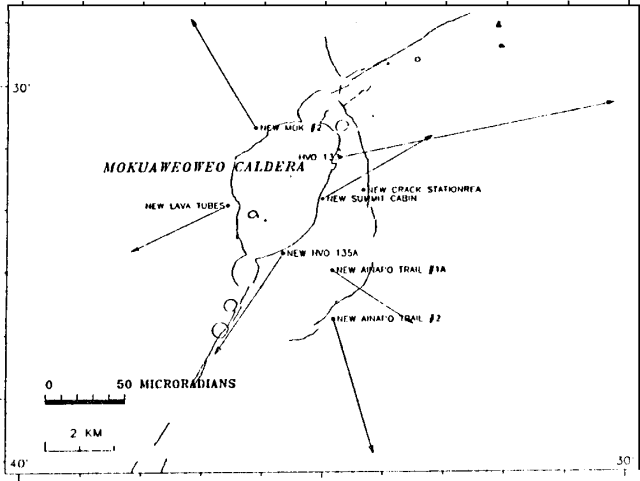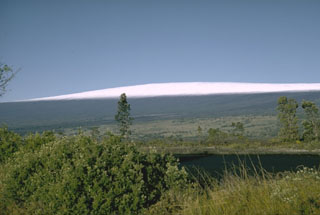Report on Mauna Loa (United States) — February 1989
Scientific Event Alert Network Bulletin, vol. 14, no. 2 (February 1989)
Managing Editor: Lindsay McClelland.
Mauna Loa (United States) 50% of 1984 deflation recovered; no shallow seismicity
Please cite this report as:
Global Volcanism Program, 1989. Report on Mauna Loa (United States) (McClelland, L., ed.). Scientific Event Alert Network Bulletin, 14:2. Smithsonian Institution. https://doi.org/10.5479/si.GVP.SEAN198902-332020
Mauna Loa
United States
19.475°N, 155.608°W; summit elev. 4170 m
All times are local (unless otherwise noted)
By 17 November 1988, when Mauna Loa's summit tilt network was relevelled, the summit region had recovered ~50% of the deflation associated with the 1984 eruption (figures 12 and 13). Intermediate-depth microearthquakes have occurred at a moderate rate in the summit region. However, the abundant shallow seismicity that originated beneath the summit crater during the year before the 1975 eruption and for 4 years before the 1984 eruption has not been observed. The absence of such precursory shallow seismicity suggests to HVO geophysicists that the next eruption . . . is several years away.
 |
Figure 12. Changes in N-S and E-W components of tilt at Mauna Loa, measured by station NEW MOK 2 on the NW rim of the caldera, 1 June 1983-17 November 1988. |
 |
Figure 13. Dry tilt changes near the summit of Mauna Loa from 23-27 April 1984 to 8-17 November 1988. Courtesy of T. Wright. |
Geological Summary. Massive Mauna Loa is a basaltic shield volcano that rises almost 9 km from the ocean floor to form the world's largest Holocene volcano. Flank eruptions typically occur from the lengthy NE and SW rift zones, and from the Moku'aweoweo summit is caldera, which is within an older and larger 6 x 8 km caldera. Two of the youngest large debris avalanches documented in Hawaii traveled nearly 100 km from Mauna Loa; the second of the Alika avalanches was emplaced about 105,000 years ago (Moore et al., 1989). Almost 90% of the surface of the volcano is covered by lavas less than 4,000 years old (Lockwood and Lipman, 1987). Beginning about 1,500 years ago, a series of voluminous overflows from a summit lava lake covered about 25% of the volcano's surface. Over the last 750 years, from shortly after the formation of Moku'aweoweo caldera until the present, an additional 25% of the volcano has been covered with lava flows, mainly from summit and NW rift zone vents.
Information Contacts: T. Wright, HVO.

